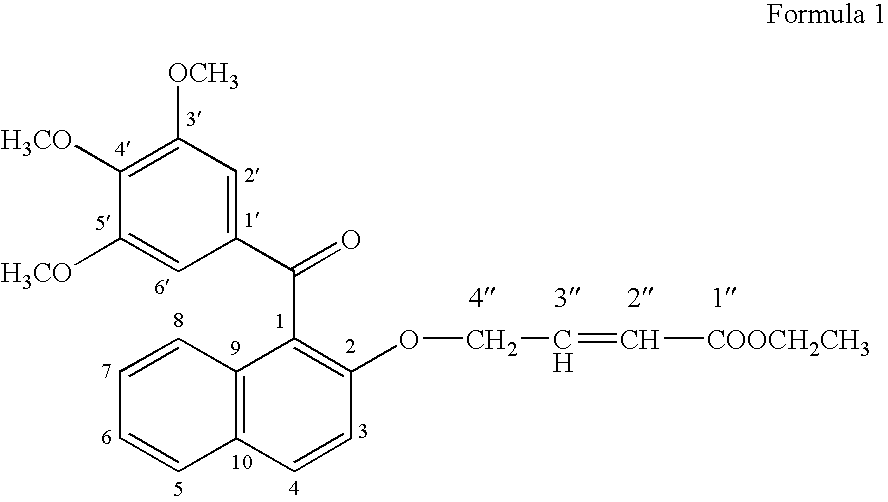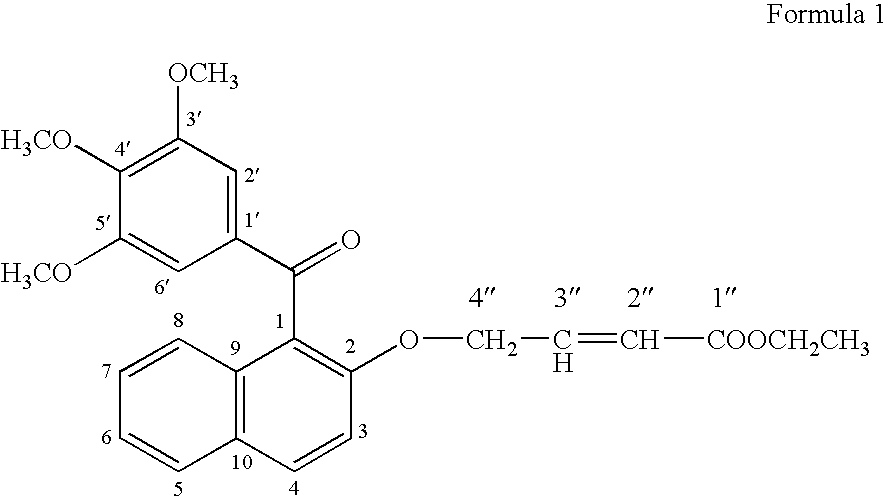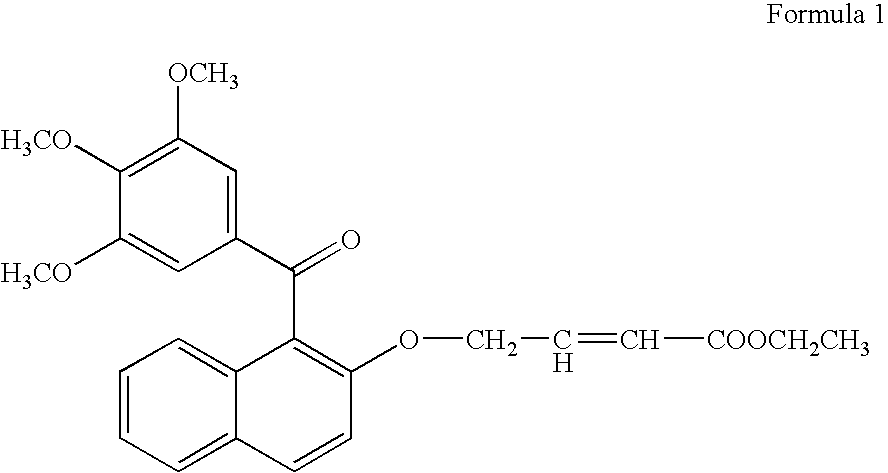Gallic acid derivative and process of preparing the same
- Summary
- Abstract
- Description
- Claims
- Application Information
AI Technical Summary
Benefits of technology
Problems solved by technology
Method used
Image
Examples
example 1
Growth Promoting Activity of Compound 1 Using Bacopa Sensor System
[0078] For testing the growth promoting effect of methanone-(3′,4′,5′-trimethoxy) phenyl, 1-naphthyl, 2-O-4″-ethyl but-2″-enoate, the compounds was dissolved in DMSO and added into the medium at 1.0 μg / ml. Only solvent was used as a control in the experiment for comparison. A fast propagating strain of Bacopa monnieri developed as a biosensor system through tissue culture at CIMAP (Khanuja et al., 2001, J Environa Pathol, Toxicol and Onco (JEPTO), 20:pp. 15 to 22) was used in the tests. The MS basal medium (Murashige and Skoog, 1962, Physiol. Planta. 15: pp. 473 to 497) supplemented with test compounds was used in the assays. Measured 0.5 to 1.0 ml medium was poured into 1.5 ml graduated microcentrifuge tubes. Twig cuttings of 2.5 cm were inoculated in 10 replicates for each treatment. These inoculated tubes were put into a half transparent desiccator allowing air passage through sterile cotton plugs fixed on opening...
example 2
Growth Promoting Activity of Compound 1 Using Aromatic Plant Species Mentha Arvensis
[0079] To confirm the growth promoting activity of methanone-(3′,4′,5′-trimethoxy) phenyl, 1-naphthyl, 2-O-4″-ethyl but-2″-enoate, it was tested with a medicinal and aromatic plant species Mentha arvensis. The explants used were 0.5 cm long pieces of the second and third internodes of the shoots formed from axillary buds and culture. The internode segments were inoculated in MS basal media (Murashige and Skoog, 1962, Physiol. Planta. 15: pp. 473 to 497) containing vitamins 100 μg / ml, myo-inositol 3%, w / v, sucrose 1.5% w / v, Agar and different concentrations of auxins and cytokinin. Different concentrations of 1-naphthalene acetic acid (NM) (0.0, 0.2, 2.0 μg / ml) were used in combination with different concentrations of 6 benzyl amino purine (BAP) (0, 10 & 5 μg / ml). On each kind of media 10 replicates of the explants were inoculated into three petriplates with each plates containing 4 explants. Compoun...
example 3
Synthesis of the Bioactive Compound Methanone-(3′,4′,5′-trimethoxy) phenyl, 1-naphthyl, 2-O-4″-ethyl but-2″-enoate
[0084] (a) Methylating gallic acid by treating it with a methylating agent and an alkali compound in a suitable organic solvent reaction medium to 3,4,5-trimethoxy benzoic acid [Gallic acid is 3,4,5-trihydroxybenzoic acid, C6H2(OH)3CO2H, colorless, odorless, crystalline organic acid found in gallnuts, sumach, tea leaves, oak bark, and many other plants, both in its free state and as part of the tannin molecule (gallotannin) (Columbia Encyclopedia, Sixth Edition, Copyright 2003). There are reports on several derivatives of gallic acid having different pharmaceutical activities.]; [0085] (b) Reacting 3,4,5-trimethoxy benzoic acid with 2-naphthol in the presence of a carboxylic acid activator in the presence of a suitable base and an appropriate organic solvent medium and then condensing and purifying the product through suitable column chromatography; [0086] (c) Subjectin...
PUM
| Property | Measurement | Unit |
|---|---|---|
| Temperature | aaaaa | aaaaa |
| Length | aaaaa | aaaaa |
| Length | aaaaa | aaaaa |
Abstract
Description
Claims
Application Information
 Login to View More
Login to View More - R&D
- Intellectual Property
- Life Sciences
- Materials
- Tech Scout
- Unparalleled Data Quality
- Higher Quality Content
- 60% Fewer Hallucinations
Browse by: Latest US Patents, China's latest patents, Technical Efficacy Thesaurus, Application Domain, Technology Topic, Popular Technical Reports.
© 2025 PatSnap. All rights reserved.Legal|Privacy policy|Modern Slavery Act Transparency Statement|Sitemap|About US| Contact US: help@patsnap.com



